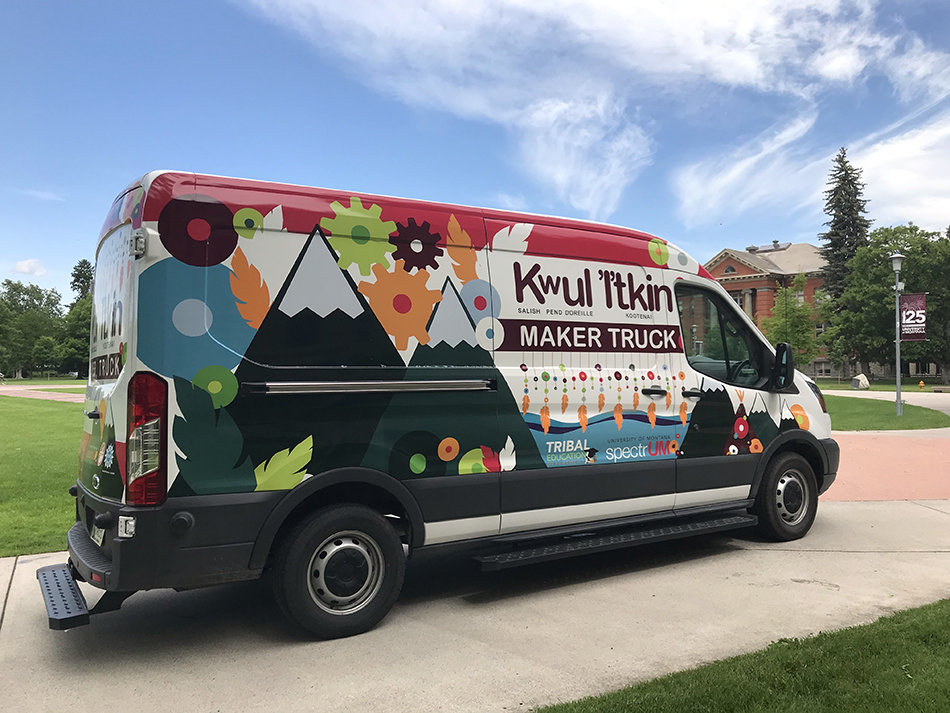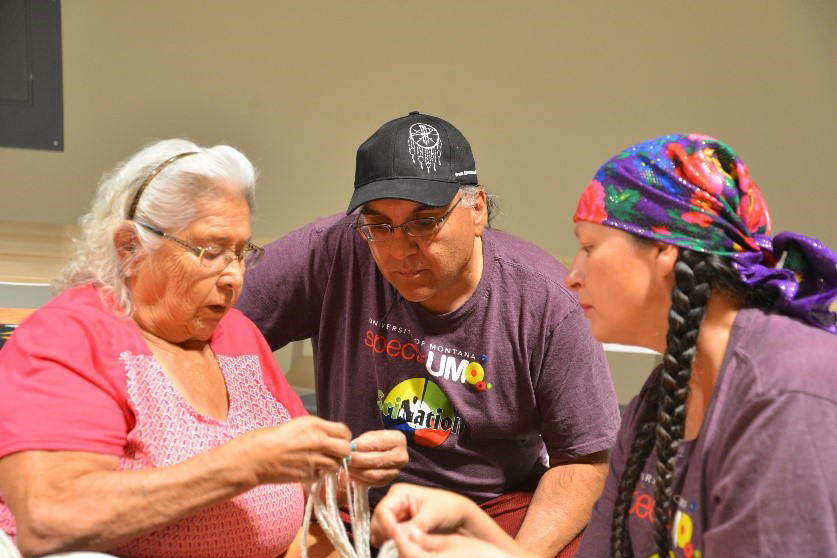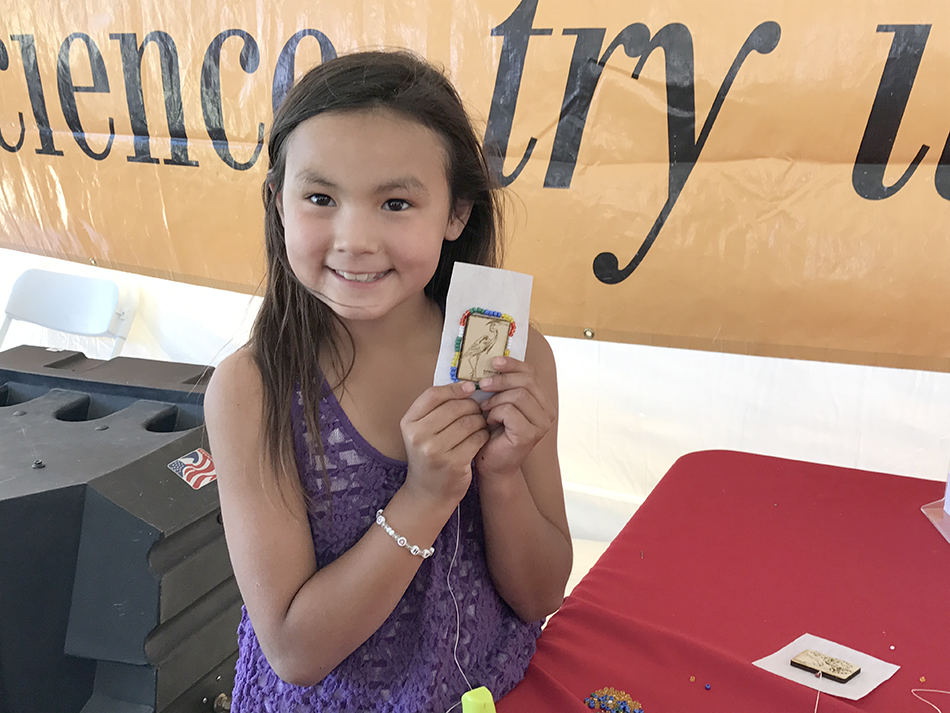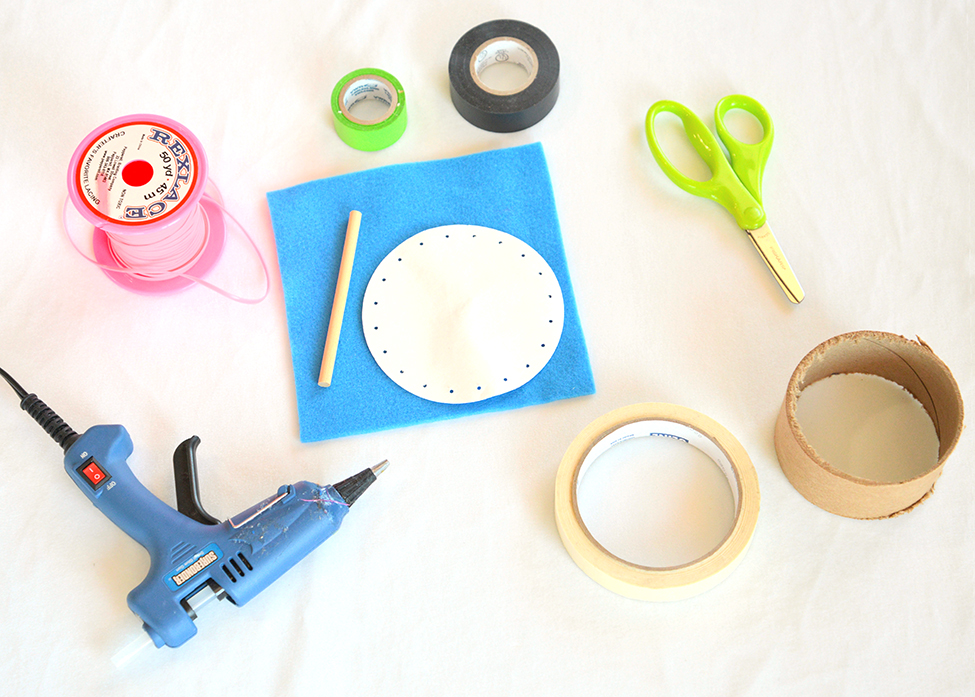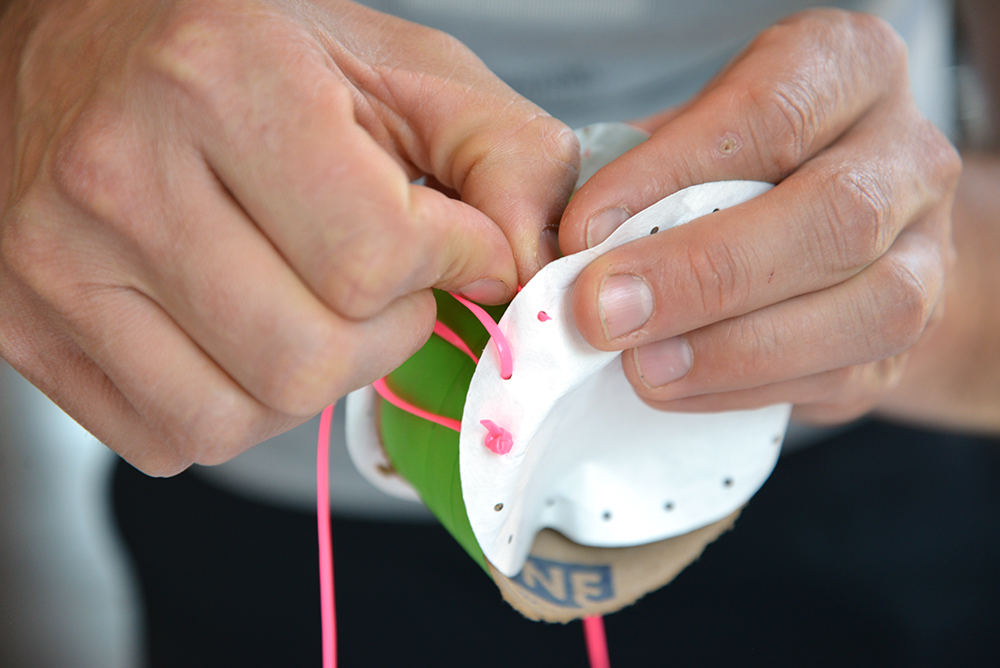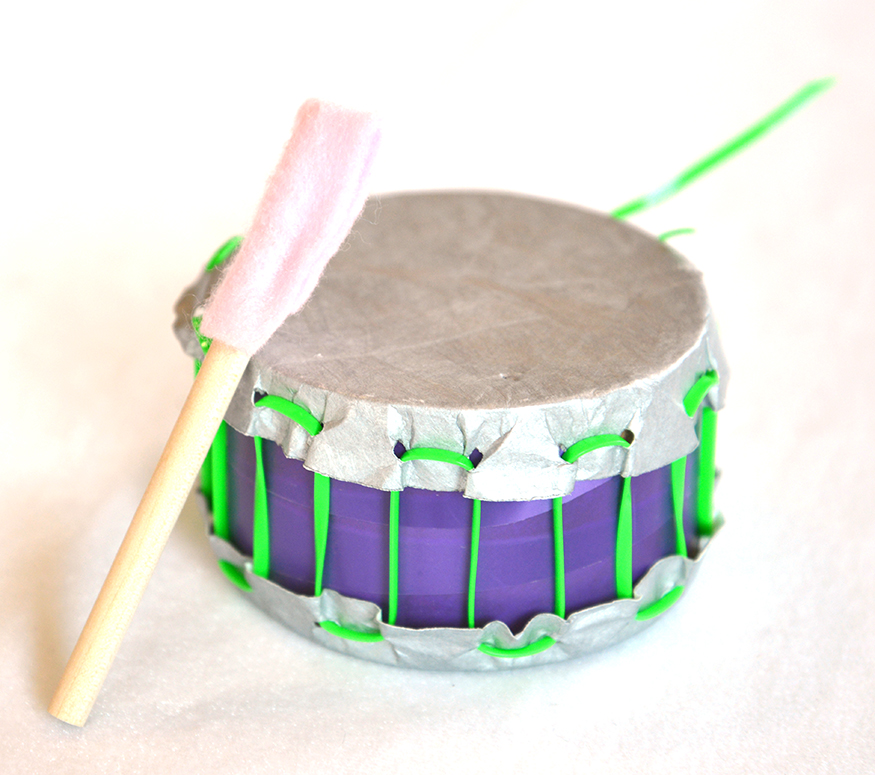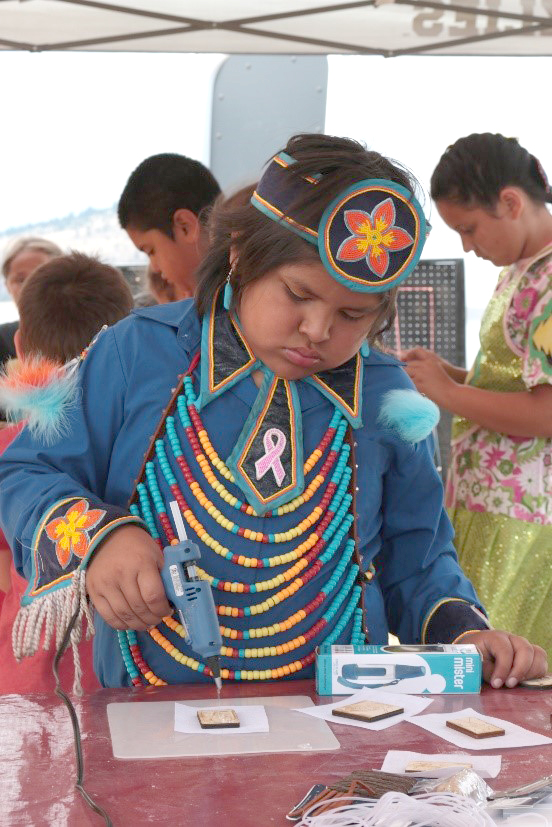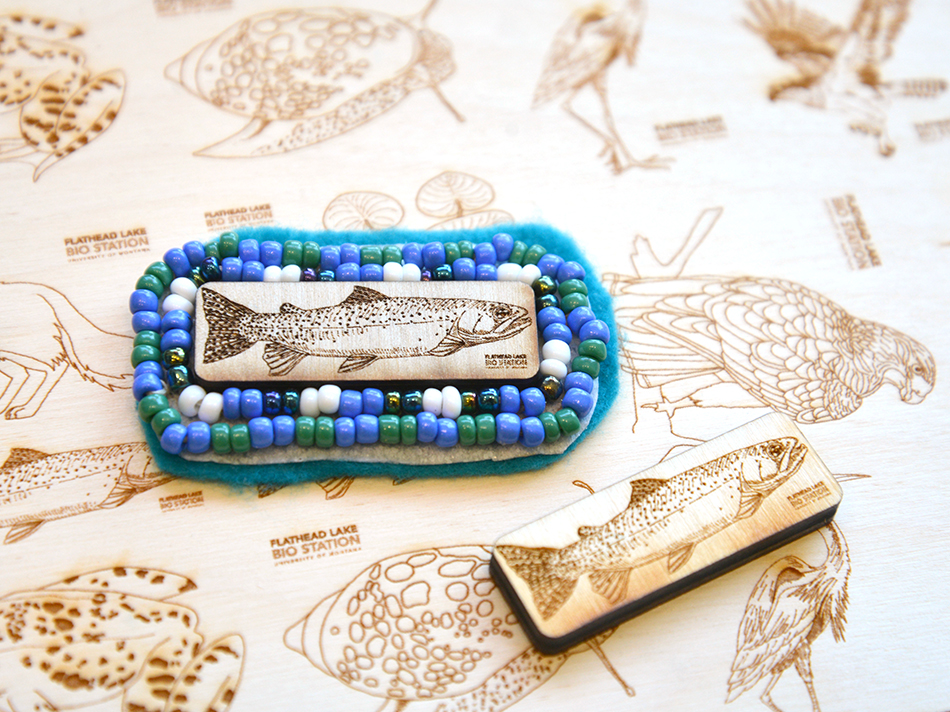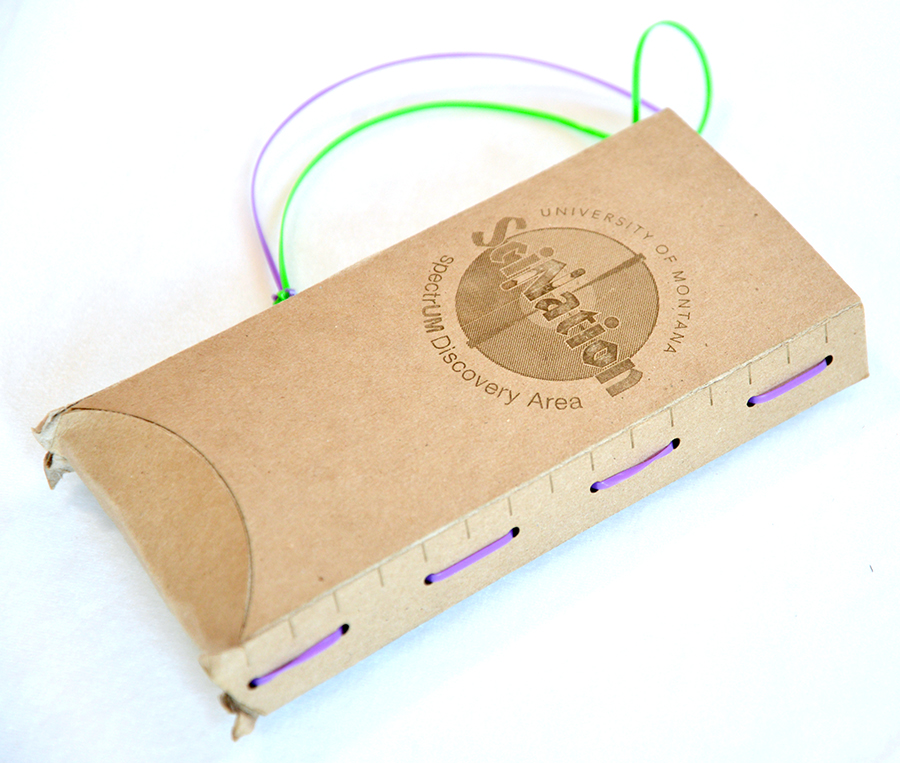Diversity and Equity
Cocreating Transformative Change
Making Collective Impact With the Flathead Nation
Connected Science Learning July-September 2018 (Volume 1, Issue 7)
By Holly Truitt, Ruth Swaney, William Swaney, Nick Wethington, and Nathalie Wolfram
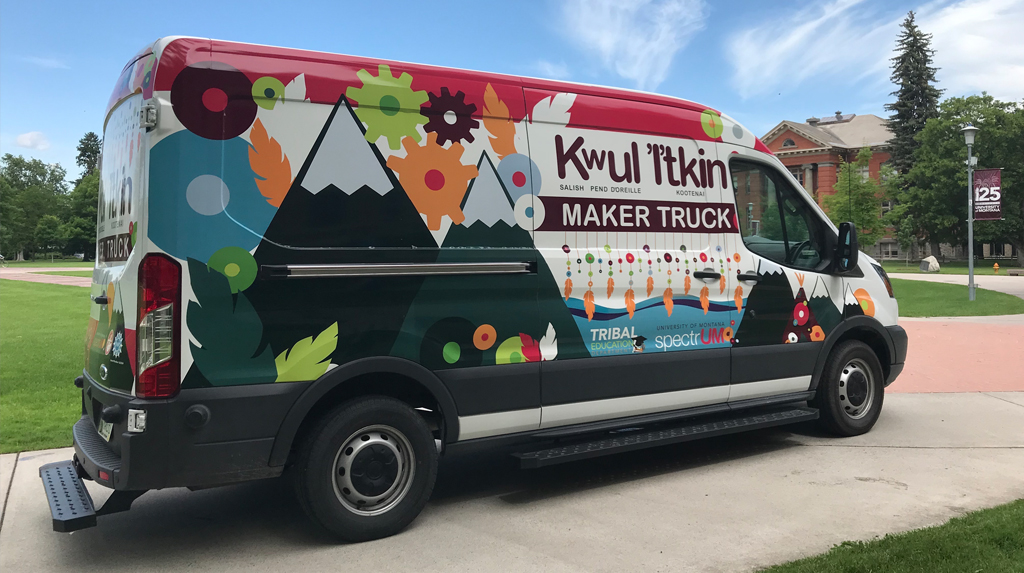
Leveraging community to create a mobile, cultural makerspace that travels to schools, powwows, and community events throughout a Native American reservation in Montana.
During a summer 2015 planning session, the University of Montana (UM) spectrUM Discovery Area and our SciNation advisory group on the Flathead Reservation took a hard look in the mirror. With the motto to “just add STEM” (science, technology, engineering, and math) to community gatherings and schools, we had together built a robust portfolio of programming that regularly engaged the reservation’s 1,200 Native K–12 students in:
- an award-winning Science Learning Tent that popped up at the reservation’s powwows,
- “Science Bytes” that embedded role models and hands-on STEM activities at summer free meal sites,
- community family science nights, and
- in-school pop-up exhibitions.
SpectrUM, a hands-on science center based in Missoula with statewide mobile programming, engages over 200,000 Montanans annually, including over 8,000 K–12 students and their families on the Flathead Reservation. Our SciNation advisory group had formed in 2013 with seed funding from the Noyce Foundation and later the Alfred P. Sloan Foundation. Collectively, we sought to reimagine spectrUM’s existing programming on the Flathead Reservation as culturally relevant, rich with Native and local STEM role models, and aligned with the Confederated Salish and Kootenai (CSK) Tribes’ workforce priorities. When spectrUM replaced our go-it-alone, organizationally bound work with a community-based, cocreative approach, increased interest, awards, and funding followed: from the Noyce Foundation, the Simons Foundation, the Coalition for the Public Understanding, and an array of federal and private foundation funding sources.
Yet we realized we were struggling to offer programming in technology and engineering, one of the tribes’ workforce priorities. And despite the strides we had made in cocreating culturally relevant STEM programming, we were falling short in providing tech programming, as well as in offering STEM engagement that is culturally relevant throughout. Taking a “balcony” view, we looked at models such as the Spark Truck, a mobile makerspace developed at Stanford and now operated out of the Deason Innovation Gym at Southern Methodist University. We asked questions such as:
- What would a mobile making experience look like on the reservation?
- How might it become uniquely of the community?
- Who might be key partners in designing the truck and its activities?
Springboarding from this 2015 planning session, spectrUM and CSK Tribal Education secured a National Science Foundation (NSF) EAGER grant for “high risk–high payoff” approaches to making and tinkering. The project brought together UM and the tribes to cocreate the Kwul ’I’tkin Maker Truck, a mobile makerspace named for the Salish and Kootenai words for “to make” and designed to travel to schools, powwows, and community events throughout the reservation (Figure 1). Owned by Tribal Education, the maker truck’s activities are culturally and locally relevant, pairing cultural and conventional forms of making through drum-making, basket-weaving, and beading activities.
Figure 1
The Kwul ’I’tkin Maker Truck reflects the visual identities of the Confederated Salish and Kootenai Tribes and spectrUM, as well as the local geography of the Flathead Reservation.
This article explores the Kwul ’I’tkin Maker Truck’s innovative approach to engaging rural, tribal students in making, STEM, and career pathways, as well as research findings from the project that indicate culture is a powerful entry point into making and STEM, both in and out of school. Although the maker truck’s cultural making activities are unique to the tribal community it serves, spectrUM and SciNation’s community-based, collective-impact approach is replicable and offers a promising model for partnerships between tribes and the museum, informal science education, and higher education fields.
SpectrUM’s cocreative, collective-impact approach
SpectrUM’s approach to cocreating with cross-sector community partners draws from Kania and Kramer’s astute observation that “large-scale social change requires broad cross-sector coordination, yet the social sector remains focused on the isolated interventions of individual organizations” (2011). Our work, including the Kwul ‘I’tkin Maker Truck project, responds to each community’s unique soils—its culture, educational landscape, and economy, including its existing STEM ecosystem and, most importantly, hopes and aspirations for its next generation.
To help identify a community’s unique soils, we often start by asking communities broad, open-ended questions such as (also see Harwood Institute for Public Innovation 2017):
- What do you want for your community and its next generation?
- Why is this vision important to you?
- How is it different from how you see things now?
- How might our collaboration support and catalyze this change?
We adopted a cocreative process that is designed to seize existing opportunities to catalyze cross-sector, community-based collaboration around a shared purpose or vision of change. The collective must believe that the process is noble and compelling enough for our partners and us to commit the time and resources to cocreate innovative, high-impact initiatives that ultimately build our collective capacity to scale to the next big opportunity that we identify.
Our process draws from existing approaches that use cocreation as a means to actively engage end users and key stakeholders in designing for change, impact, and, at times, transfer of ownership (Jansen and Pieters 2018; Gouillart and Hallet 2015; Brown and Wyatt 2010; IDEO 2018). It works to actualize the sentiment of Tim Brown, CEO and president of the international design and consulting firm IDEO, who said, “We need to invent a new and radical form of collaboration that blurs the boundaries between creators and consumers. It’s not about ‘us versus them’ or even ‘us on behalf of them’ … it has to be us with them.”
In implementation, this highly community-driven and collaborative process has four core phases that are meant to be iterative and circular:
- Build a community-based, cross-sector collective around an existing opportunity and a shared vision for collective impact that is more effective than what could be done alone (Kotter 1996). These collectives look different in each community but always include a high-impact committee of like-hearted individuals from an array of sectors and backgrounds who participate in the design and implementation of all programming.
- Codesign—through rich discourse, prototyping, and often multiple iterations of an experience, program, or initiative—to help catalyze the desired change.
- Implement and evaluate at all phases to create feedback loops on the design process, refine based on the greater community and end users’ experiences, and share lessons learned with other communities.
- Build the collective’s capacity to springboard to the next opportunity and, where appropriate, transfer ownership of cocreated programs and experiences to community partners.
All four phases work to incubate the five conditions that Cea and Rimington (2017) identify as essential to cocreated innovation:
- Share power (participants in the design process are designers, decision-makers, and, at times, implementers).
- Put relationships first and codesign second (the collective focuses its attention first on building lasting relationships and second on codesigning).
- Leverage heterogeneity (the bringing together of disparate thinkers, cultures, and experts to ensure novel ways of thinking and doing).
- Prototype early and often.
- Legitimize all ways of knowing.
Codesigning the Kwul ’I’tkin Maker Truck
With members from the Tribes’ Education, Health, and Natural Resources departments, as well as K–12 schools on the reservation and UM, spectrUM’s SciNation advisory group formed around the goal of building a homegrown, Native STEM workforce in health care, the environment, and technology. Children on the Flathead Reservation experience significant barriers to education and economic success. The unemployment rate among tribal members on the reservation is more than triple the statewide rate (CSKT Economics 2014). By high school, just 22% of Ronan students are considered advanced or proficient in science, compared to 62% statewide (Montana Office of Public Instruction 2017). S&K Technologies, a tribally owned aerospace, technology, and logistics conglomerate, aspires to employ Native STEM professionals but currently relies primarily on non-Native employees in those roles.
Figure 2
Salish elder Eva Boyd guides SciNation member and former tribal education director Bill Swaney and spectrUM partner Dr. Ruth Swaney in a basket-weaving activity as part of the codesign process.
Although confident about our ability to cocreate high-impact STEM experiences, we collectively recognized that incorporating culture into our programming required that spectrUM take “second chair” to the tribes in facilitating the codesign of the maker truck and its activities. Bill Swaney, then head of Tribal Education, a member of SciNation, and a co–primary investigator on the NSF project, stepped up to lead the cultural aspects of the cocreation process, with spectrUM’s education team bringing expertise in making and STEM engagement. Swaney used a highly iterative process in designing the maker truck’s visual identity and its cultural making activities. The process engaged the tribes’ culture committees, the People’s Center (the museum and cultural center of the Salish, Kootenai, and Pend d’Oreille peoples), and a dozen knowledge-keepers and elders (Figure 2). Dr. Lisa Blank, who used a reciprocal research model that engaged the community in all stages of designing the project’s research questions and methods, interviewed participants in the activity design process. One elder told her, “One of the things that drew me to the project is it is collaborative … the cocreation process makes it easy to want to contribute and then makes it easier to bring up some of the more sensitive questions about, for lack of a better term, potential cultural appropriation. Everybody has said, ‘Okay, let’s go in a different direction if we need to or what do you suggest we do.’”
Figure 3
A child at the Arlee Celebration displays her beading project, showing the laser-engraved cab surrounded by a beaded design.
Through a series of design charrettes and visits with the culture committees, SciNation identified three culturally relevant and appropriate activities for blending cultural making techniques with contemporary materials and rapid prototyping technologies: drum-making, beading, and basket-making. spectrUM’s education team, Dr. Blank, and SciNation members took part in the People’s Center’s weekly traditional arts circle to learn how traditional drums are made from rawhide and wood, and to practice beading patterns and methods. spectrUM’s resident maker Nick Wethington and head of education Jessie Herbert-Meny developed laser-cut prototypes of cabs—the central fixtures in a beaded piece—to incorporate into the maker truck’s beading activity (Figure 3). Staff and elders at the People’s Center provided feedback on each iteration of the emerging making activities, even helping identify a material suitable for laser cutting that mimics the sound of the very tightly stretched rawhide of a traditional drum. As Dr. Ruth Swaney, a codesigner of the project’s cultural making activities, said, “The process of utilizing contemporary technology with various traditional crafts is not a new idea for Native people, who have always been adaptive and innovative.”
Figure 4
The drum-making activity uses readily available supplies, including Tyvek mailing tubes precut on the maker truck’s laser cutter, hot glue, and plastic lanyard.
The maker truck’s drum-making activity uses Tyvek mailing tubes precut by the laser cutter into circles with holes around the perimeter (Figure 4). Children lace the drum heads with plastic lanyard material and can explore how the sound varies depending on how tight or loose the drum head is (Figures 5 and 6). They make their own drum sticks by hot-gluing felt to a dowel. Because the lacing pattern of traditional drums and the designs of drum sticks vary, participants are encouraged to experiment with the lacing of their own drums and the design of their drum sticks, and to compare their creations with others’.
Figure 5
Children create their own lacing pattern and can explore how their unique design impacts the drum’s sound.
The maker truck’s beading activity closely follows the traditional method of beading. Children glue a thin piece of plywood engraved with an animal or logo—rather than the traditional stone, shell, or horn—to pellon, a material that mimics the properties of thick leather but is much easier to sew. Using their choice of colors and patterns, they can create a necklace, bracelet, or earrings (Figure 7). UM’s Flathead Lake Biological Station, located on the Flathead Reservation, created a series of images for the cabs that spotlight native Montana species, providing conversation starters about local wildlife (Figure 8).
Figure 8
A completed beading project, with a laser-engraved cab designed by UM’s Flathead Lake Biological Station to feature local, native wildlife.
Although the drum-making and beading activities are well-suited to informal settings such as powwows and fairs, the project’s basket-weaving activity was designed for in-depth facilitation in classroom settings. Tribal elders Myrna Boyd and Eva DuMontier, along with Swaney, led trainings on methods of making baskets made from cedar bark and yarn. Through this collaborative process, the project team identified readily available and sustainable materials to take the place of actual cedar bark or reeds. In the resulting activity, thin cardboard sheets are precut on the laser cutter into a pattern that folds into the shape of the basket. Children lace the basket together using the same lanyard material as is used in the drum-making activity (Figure 9).
Figure 9
Designed for facilitation in classrooms, the basket-making activity uses cardboard and lanyard in place of cedar bark and cordage.
What we’re finding
This project used a community-based, participatory research model in which the community codesigns the research questions, methods, and protocols (Harding et al. 2012). Dr. Blank and the project team met with the Tribal Council, culture committees, and SciNation to shape and refine the central research question: “Does community involvement in cultural makerspace programming advance design thinking and capacity to participate in making?” At these meetings, members of the tribes identified existing cultural making practices that they considered appropriate to include in this project—including basket-weaving, drum-making, and beading—as well as other cultural practices that they deemed sacred or otherwise inappropriate for this project. Mindful of well-documented harms that have resulted from research conducted “on” rather than “with” Native American tribes, the Tribal Council also worked with Dr. Blank and our project team to codesign survey and interview questions, as well as to define how and with whom the resulting data could be shared. Throughout, tribal members have shared in the process, methods, analysis, and results of the project.
We began with a pilot study and brought the results to Tribal Education and other community partners to review and refine before we scale-up this year. Although time-consuming, this tribal–university participatory approach builds trust and helps ensure that the research benefits the community. We are also finding that it is building capacity: After reviewing this project’s pilot findings, both Tribal Education and a collective-impact college and career readiness project based at Salish Kootenai College have decided to adopt the same questions in their own program research and evaluation.
Early findings from the project’s pilot research suggest that cultural making activities spark greater engagement. Dr. Blank, then a professor of education at UM, found that in the informal setting of powwows, children spent an average of 29 minutes at cultural STEM making experiences versus seven minutes at noncultural STEM making activities, with equal participation by males and females. Adults were also more likely to engage with their children at the beading and drum stations (Blank and Truitt 2017).
Dr. Swaney, who facilitated the project’s activities at powwows, noted that the activities also provided entry points into culture as well as STEM; she said, “When we introduced the beading activity, young people enjoyed the laser-printed images of wildlife, which created an opportunity to talk about wildlife biology or their own observations of those species. To a certain extent, we could also apply a cultural overlay from our community to some animals as they related to the oral histories of tribes, bringing an additional perspective of animals to youth that they might not get in a mainstream educational setting.”
Pilot research conducted on the project’s classroom engagement similarly indicates that cultural making offers new entry points for K–12 students into making and design. For example, of 78 students surveyed at five middle schools on the Flathead Reservation after participating in the project’s basket-weaving activity,
- 81% strongly agreed or agreed that “During this activity, I was focused on learning about the design process most of the time,”
- 71% strongly agreed or agreed that “During this activity, I learned a lot about how to plan and design,” and
- 68% strongly agreed or agreed that “After doing this activity, I am excited to make and design other projects.”
Responses to the open-ended survey question, “A design project I would like to make now is … because …” suggest that students recognized and valued the activity’s cultural component. Sample responses included: “Bead, beading is a great way to allow my imagination to flow. You can create countless designs. Because my family is very talented in beading …” and “… I liked the baskets but I would like to make coultral stuff because I liked to learn about coulture.”

Forthcoming research will address Kwul ’I’tkin Maker Truck’s impact on tribal capacity for making, which, anecdotally, appears to be growing as Tribal Education increasingly brings the maker truck and its activities to its own programming, independent of spectrUM.
Lessons learned on cocreating community-based collective impact
During the period since spectrUM adopted a community-based, collective-impact approach throughout our work, we have grown from engaging 50,000 people to 200,000 people annually. In Missoula, we have opened a first-of-its-kind learning center, EmPower Place, which is embedded in our local food bank and devoted to providing rich science museum and library programming to children and families experiencing food insecurity. With cross-sector partners, we are two years into cocreating a robust maker culture in rural schools in the Bitterroot Valley; partly as a result of this initiative, the community is using funds from a recently passed bond to create a makerspace within its school library. In Missoula, we are breaking ground on a beautiful new culture house that will bring spectrUM, our public library, and Missoula’s children’s museum under a single roof, with free admission. spectrUM now regularly receives invitations to help others around the nation develop their own community-based, cocreative efforts.
On the Flathead Reservation, spectrUM and SciNation’s cocreative work most recently garnered an award from the Montana Indian Education Association. As a case study in community-based collective impact, the Kwul ’I’tkin Maker Truck offers lessons for other communities, higher education institutions, museums, and K–12 schools interested in adopting a similar approach to codesigning highly localized and community-driven STEM and making initiatives, especially in Indian Country. Below are some of the key lessons we learned in this collective-impact approach:
- So basic, but all too often forgotten: Relationships first. Always. We are often so focused on the end product that we forget to pay attention to the process and the glue that holds the process together: our cocreators. Relationships first, cocreation second, as the cocreative process is only as strong as the trust in the room. To cocreate, you must listen to each other, dream together, and recognize and value one another’s unique expertise. Our recommendation is to share food, meet monthly, build relationships, and, of course, cocreate. This is especially true when working with tribal communities. In our work, relationships have been fostered over many years. We have found that you can only move as fast as the trust in the room.
- Give the keys to the community. The process of cocreation is a redistribution of power back to the community and is built on a foundation of trust and respect. By including community in all aspects of the process, partners invest time and resources and take ownership of both wins and challenges. Moreover, we are finding that when higher education designs with community capacity and ownership in mind, better solutions, deeper social impact, and stronger goodwill and collaboration result, particularly with underserved communities that often feel (and have been) overlooked by academic institutions and museums.
- Never problems, always wicked opportunities. In the social sciences, “wicked problems” are those complex, persistent problems such as hunger or homelessness that no single organization could solve on its own or with a single intervention. Our cocreation process focuses on harvesting “wicked opportunities” rather than combatting problems. This asset rather than deficit approach allows us to collectively adopt the growth mindset that we in education so often prescribe to our young makers. Too often in the informal science and higher education world, we build a case and frame a community by what is absent rather than what already exists or might be leveraged or cocreated within the community. Dr. Heather Cahoon, a celebrated poet, policy analyst, and enrolled member of the Pend d’Oreille Tribe on the Flathead Reservation, recently shared that “a very common saying in tribal communities is that if the problems are in the community, the solutions are in the community.” We need to focus on these solutions.
- Think like a gardener: Know your community’s soil and cocreate accordingly. The soil of a community matters when trying to create transformative change. By “soils” we mean “place,” including a community’s economic landscape, local career and educational pathways, culture, history, and, perhaps most importantly, its hopes and dreams for its next generation. Bold things happen when we codesign spaces, programs, and experiences that are of the soils of the community, drawing from their knowledge, economy, workforce and educational needs, and culture rather than simply importing cookie-cutter approaches. Recent research suggests that clear pathways into local industries are among the factors that contribute to a child’s upward mobility (Rothstein 2017); in other words, community soils matter.
- Culture + STEM = Expanded relevancy, broadened partnerships, and diversity of design questions, opportunities, and entry points. By bringing new, heterogeneous voices to the table, we began to ask new design questions that led to novel approaches to our STEM and making experiences on the Flathead Reservation. Our boldest question was: How might we bring a cultural overlay to our maker truck? And who might we empower to lead these design efforts? How might cultural making impact K–12 learners and their families’ engagement with STEAM (science, technology, engineering, art, and math)? These questions led to new and deeper partnerships. Montana’s Indian Education for All constitutional mandate, CSK Tribal Education, and the tribes’ culture committees were powerful champions for weaving STEM and culture together. By bringing STEM champions arm and arm with tribal elders and knowledge keepers, the Kwul ’I’tkin Maker Truck is opening new entry points for Native K–12 students who might come for the culture but stay for the STEM.
Anu Partanen (2018) describes a “Nordic theory of love” as a state of equity of all relationships, including through the design of policies and systems that free individuals from dependency. She writes, “the express purpose of this freedom is to allow all those human relationships to be unencumbered by ulterior motives and needs, and thus to be entirely free, completely authentic, and driven purely by love.” Cocreation works to do this for us and our community partners, transferring power to allow us to become equals working on innovative new models that are of the community, grounded in authentic relationships, and aligned with the very human, shared purpose of bettering the lives of our next generation. This process ultimately allows us to ask again and again the same vital questions: To what end do we cocreate? Where are there gaps between what we created and the change we want to see in the world? Who in our community should we invite to help us be the change?
Holly Truitt (Truitt.Holly@gmail.com) is the founder and principal of Holly Truitt Consulting, a community-driven innovation and design firm. She serves as the founding director of ONE, Missoula’s inclusive innovation and prosperity initiative. Currently, she is principal investigator on a National Institutes of Health SEPA grant that is rich with community cocreation. Holly was the founding director of the spectrUM Discovery Area at the University of Montana in Missoula. She enjoys teaching at institutions like Stanford d. school and University of Montana. Ruth Swaney (rswaney@mhanation.com) is tribal education director at the Mandan, Hidatsa, Arikara Nation in New Town, North Dakota. William Swaney (Swaney.William@gmail.com) is environmental health specialist at Elbowoods Memorial Health Center in New Town, North Dakota. Nick Wethington (nicholos.wethington@umontana.edu) is the making and tinkering program manager for spectrUM in Missoula, Montana. Nathalie Wolfram (nathalie.wolfram@umontana.edu) is director of the Broader Impacts Group at the University of Montana in Missoula, Montana.



